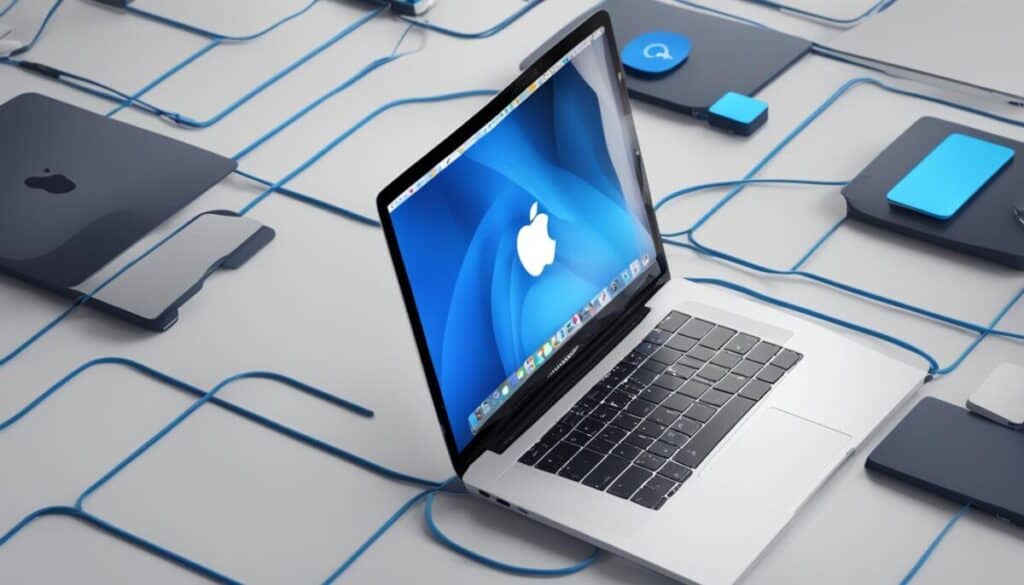Are you tired of constantly being prompted to input passwords for your Keychain Mac? If so, you’re not alone. Many users have been experiencing this frustrating issue that seems to persist no matter what they try. In this article, we will delve into the reasons behind this problem and provide you with some solutions to resolve it.
Key Takeaways:
- Users have been experiencing constant password prompts for Keychain Mac.
- This issue is not related to malware or security threats.
- The problem stems from a synchronization issue between the login password and the keychain password.
- Solutions include turning off Keychain Auto-Lock, changing the password for the login keychain, or creating a new login keychain.
- Additional troubleshooting steps may be required if the initial solutions don’t work.
Understanding the Keychain Mac Password Prompt Issue
The Keychain Mac is a crucial password management system that enables users to securely store and manage their passwords for various apps and services on their Mac. One of its key features is the ability to automatically fill in passwords, making the login process more convenient for users. However, some users have been facing a persistent issue where they are repeatedly prompted to input their passwords for Keychain Mac.
This problem is not related to any malware or security threats; instead, it stems from a synchronization problem between the login password and the keychain password. Essentially, when the login password and keychain passwords become out of sync, certain processes and apps have difficulty accessing the keychain, leading to the recurring password prompt. It’s important to note that this issue primarily affects the macOS Keychain system and not the individual apps or services that rely on it.
To better understand this issue, imagine having two separate locks for the same door. If the keys for these locks are not synchronized, you would need to unlock both locks separately every time you enter the room. Similarly, the Keychain Mac password prompt issue occurs when the login and keychain passwords are not aligned, causing users to repeatedly input their passwords for the keychain.
Reasons Behind the Keychain Mac Password Prompt
Several reasons contribute to the Keychain Mac password prompt issue. One of the main triggers is the process called “com.apple.iCloudHelper.” This process is responsible for managing login credentials for various apps and services on your Mac. It constantly changes to different apps, causing the password prompt to appear. When the login password and keychain passwords are out of sync, these processes and apps encounter difficulty accessing the keychain, resulting in the repeated password prompts.
Another factor that can lead to the password prompt is the management of keychain access. If you or an administrator changes the login password, it can cause a mismatch with the saved keychain passwords, leading to the frequent password prompts. This issue is not related to any security threats or malware, but rather a synchronization problem between the login password and the keychain password.
To resolve this problem, it’s important to address the synchronization issue between the login password and keychain passwords. By understanding these underlying reasons, users can take appropriate steps to resolve the Keychain Mac password prompt issue and regain seamless access to their keychain passwords.
Resolving the Keychain Mac Password Prompt Issue
If you’re tired of constantly being prompted to enter passwords for Keychain Mac, there are several solutions you can try to resolve this issue. Here are some steps you can take:
- Turn off Keychain Auto-Lock: In Keychain Access, deselect the option to automatically lock the keychain. This may prevent the recurring password prompt.
- Change the password for the login keychain: In Keychain Access, navigate to the Edit menu and choose “Change password for keychain ‘login’.” Enter the previous user password and set a new password for the keychain.
- Create a new login keychain: If the above solutions do not work, users can create a new login keychain. This involves making a copy of the existing keychain, renaming it, and adding it to Keychain Access. The new keychain will have the same password as the user account.
By following these steps, you should be able to resolve the Keychain Mac password prompt issue and ensure a smoother experience with your Keychain Mac.
Troubleshooting Keychain Mac Password Prompt Issue
If the previous solutions do not resolve the Keychain Mac password prompt issue, there are additional troubleshooting steps you can try:
- Reset default keychains: In Keychain Access, click on the Keychain Access menu, choose “Settings,” and click on “Reset My Default Keychains.” This will create new empty login and iCloud keychains with the same password as your user account.
- Add Keychain: In Keychain Access, go to the File menu and choose “Add Keychain.” Select the keychain file on your desktop and add it to Keychain Access. This will import the old keychain and its entries to the new login keychain.
- Check iCloud Keychain settings: Ensure that iCloud Keychain is turned on and properly synced with your Mac. Open System Settings, go to AppleID or iCloud, and make sure that “Passwords & Keychain” or “Keychain” is turned on.
By following these troubleshooting steps, you can further diagnose and resolve the Keychain Mac password prompt issue. Remember to restart your Mac after attempting each solution to ensure that the changes take effect.
“I tried the solutions mentioned in the previous sections but the password prompt issue still persists. What else can I do to resolve this problem?” – User123
If the issue persists even after trying the troubleshooting steps, it is recommended to contact Apple Support for further assistance. They can provide more specific guidance and solutions tailored to your particular situation.

Understanding the Role of accountsd, callservicesd, and assistantd
The smooth operation of the Keychain Mac and its synchronization with iCloud Keychain relies on several essential macOS system processes. These processes include accountsd, callservicesd, and assistantd, each serving specific functions on the Mac. Understanding their roles can help users manage their Keychain Mac effectively and ensure seamless access to their stored passwords and account information.
accountsd
accountsd is a critical macOS process responsible for handling the synchronization of data over iCloud Keychain for various apps and services. It ensures that changes made to passwords or account details on one device are reflected across all devices connected to the same iCloud account. By maintaining this synchronization, accountsd enables users to access their updated login credentials seamlessly.
callservicesd
callservicesd is another important process that manages call-related apps on a Mac, such as FaceTime and Contacts. It ensures the smooth functioning of these apps by handling call-related functionalities, including user authentication and contact synchronization. By facilitating the proper operation of call-related services, callservicesd enhances the overall user experience on the Mac.
assistantd
assistantd is a macOS process closely associated with Siri and dictation services. It handles the processing and execution of requests made through Siri, as well as the transcription and interpretation of spoken words for dictation purposes. assistantd requires access to the iCloud Keychain to retrieve user-specific data, such as stored passwords and account information, in order to provide personalized responses and assistance.

Understanding the roles of accountsd, callservicesd, and assistantd in the macOS ecosystem is crucial for managing the Keychain Mac effectively. These processes work behind the scenes to ensure the synchronization of data, the seamless functioning of call-related apps, and the provision of personalized assistance through Siri. By comprehending their functions, users can troubleshoot Keychain Mac issues more efficiently and make the most of this password management system.
Ensuring Security and Privacy on Mac with Keychain Mac
When it comes to Mac security, Keychain Mac plays a crucial role in safeguarding your passwords and sensitive information. However, to further enhance your security and privacy, there are additional steps you can take.
First, consider using a trusted tool like CleanMyMac X to repair disk permissions. By fixing broken disk permissions, you can address any issues related to accessing certain folders or account permissions, ensuring a more secure environment for your data.
Another important aspect of Mac security is managing app permissions. CleanMyMac X allows you to easily revoke unnecessary permissions and remove sensitive data from your browsers. By doing so, you can minimize the risk of unauthorized access to your camera, microphone, and Wi-Fi network, protecting your privacy.
While Keychain Mac is a reliable password management system, you may also choose to use a dedicated password manager like Secrets. By utilizing a password manager, you can securely store your passwords and other sensitive information, reducing your reliance on Keychain Mac and providing an additional layer of protection.
Conclusion and Making the Most of Keychain Mac
In conclusion, the Keychain Mac password prompt issue can be resolved by ensuring password synchronization, adjusting Keychain Auto-Lock settings, or creating a new login keychain. By following these steps, users can regain control over their password management system and eliminate the constant prompts for password input. Keychain Access, a built-in feature of macOS, is a powerful tool that allows users to manage their keychain passwords effectively, making it easier and more secure to access various apps and services.
Understanding the role of processes like accountsd, callservicesd, and assistantd can also aid users in troubleshooting issues related to Keychain Mac. These processes are essential to the seamless operation of features like iCloud Keychain, call-related apps, Siri, and dictation. Users can rest assured that these processes are designed to enhance their overall Mac experience and ensure the proper functioning of associated services.
For users who want to go the extra mile in terms of security and privacy, tools like CleanMyMac X can be incredibly useful. This software provides the ability to repair disk permissions and manage app permissions, further safeguarding sensitive data and protecting privacy. Additionally, considering a dedicated password manager like Secrets can reduce reliance on Keychain Mac and provide an extra layer of security for passwords and other sensitive information.
FAQ
Why am I constantly prompted to input passwords for Keychain Mac?
This issue is caused by a password synchronization problem between the login password and the keychain password. When these passwords become out of sync, certain processes and apps have trouble accessing the keychain, prompting you to input your password.
How can I resolve the Keychain Mac password prompt issue?
You can try the following solutions:
– Turn off Keychain Auto-Lock in Keychain Access.
– Change the password for the login keychain in Keychain Access.
– Create a new login keychain if the previous solutions don’t work.
– Reset default keychains in Keychain Access.
– Add Keychain in Keychain Access.
– Check iCloud Keychain settings in System Settings.
What are accountsd, callservicesd, and assistantd, and what do they do?
These processes are essential macOS system processes responsible for various functions on your Mac. Accountsd handles synchronization of data over iCloud Keychain, callservicesd maintains call-related apps, and assistantd is related to Siri and dictation. They require access to iCloud Keychain to function properly and ensure the seamless operation of related services.
How can I enhance security and privacy on my Mac with Keychain Mac?
You can take additional steps such as repairing disk permissions with CleanMyMac X, managing app permissions, and using a dedicated password manager like Secrets to minimize reliance on Keychain Mac.
How can I make the most of Keychain Mac?
By understanding the password synchronization issue, resolving the password prompt problem, and utilizing tools like CleanMyMac X, you can ensure a secure and efficient experience with Keychain Mac.

